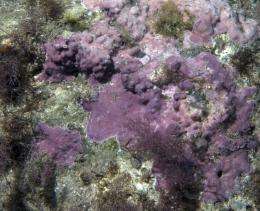The adherence mechanism of red algae to the rocks is discovered

Geologists of the University of Granada, Spain, have described for the first time ever the biological mechanism that explains how calcareous red algae grow on rocky substrates.
This is an amazing finding that has allowed us to know the physiology of this type of algae better and explain an existing paradox in the field of palaeontology: the lack of these algae in sedimentary rocks of fossil cliffs. In particular, an organic layer lying between the red algae that grow on rocks and the stone surface has been discovered. Indeed this is an organic thin layer of polysaccharides, very efficient during the growth and development of algae, but once the algae dies, this layer has no longer adherence and causes algae to come away from the substrate where they live.
Juan Carlos Braga, Antonio Checa and Julio Aguirre, researchers from the palaeography and sedimentary basin group of the Department of Stratigraphy and Palaeontology, have made such discovery after developing two projects funded by the Spanish Ministry of Science and Innovation. Red algae, organisms that live stuck on shore cliffs which are also abundant in the rocky surfaces of the Spanish beaches, which in some cases, is up to 60% of the total surface. However, such algae are not stuck to their usual substrates in the fossil record. In order to find an answer to this phenomenon, the reason why these algae perish with the pass of time and disappear from the fossil record has now been found out.
'With our research work, it was clear for us that the key could be in the adherence system that rhodophyta use, but it is a topic that no researcher in the world had planned to research into so far, and consequently we are very happy with the results', Julio Aguirre said.
Red algae are organisms that calcify their skeleton, that is, their cell walls of their cells precipitate calcium carbonate, and therefore have an enormous relevance as fossils. They are organisms very usually found in any marine fossil basin. There are many different species on sedimentary remains, but they are not stuck on the walls of old cliffs.
The group of geologists has carried out field work in areas by the Almeria shore cliffs, where they took samples of live rhodophyta (specific name of the wide group of red algae) stuck on cliffs and rocks. Later on, they took photos with the electronic microscope and thanks to them they identified the layer that allows algae to adhere to solid surfaces. After isolating it and carrying out basic biological trials, they realised it is a type of highly effective polysaccharide. In addition to explaining how these organisms stuck to fix substrates, this fact also shows their versatility to produce a large number of substances.
Stabilizers and emulgents for nourishment
Red algae make up a group of very interesting organisms due to their characteristics. Some species are used as nourishment; and the food industry uses them as additives and stabilizers or emulgents.
There are two groups of calcareous red algae in the nature: unarticulated and articulated. The algae in the first one calcify all their cells, therefore they fossilize very well and last through geological time. The other group is worse represented in the fossil record as it is made up by algae that are ramified in a sort of small bushes representing groups of non-calcified cells. This causes the disarticulation and fragmentation of the remains of articulated algae after they die, which gives rise to a deficient fossil record.
There are two main types of unarticulated red algae, depending on their ecology: those that grow as an algal crust on rocky surfaces and those that develop as rhodoliths. Rhodoliths are algae that grow with a spherical shape around a solid nucleus to which they adhere. Such nucleus can be a piece of shelly rock or a similar substrate. In both cases the adherence mechanism of these red algae identified by scientists of the UGR is valid and implies an enormous advance in the knowledge of the biology and ecology of these living beings.
Source: Andalucía Innova


















